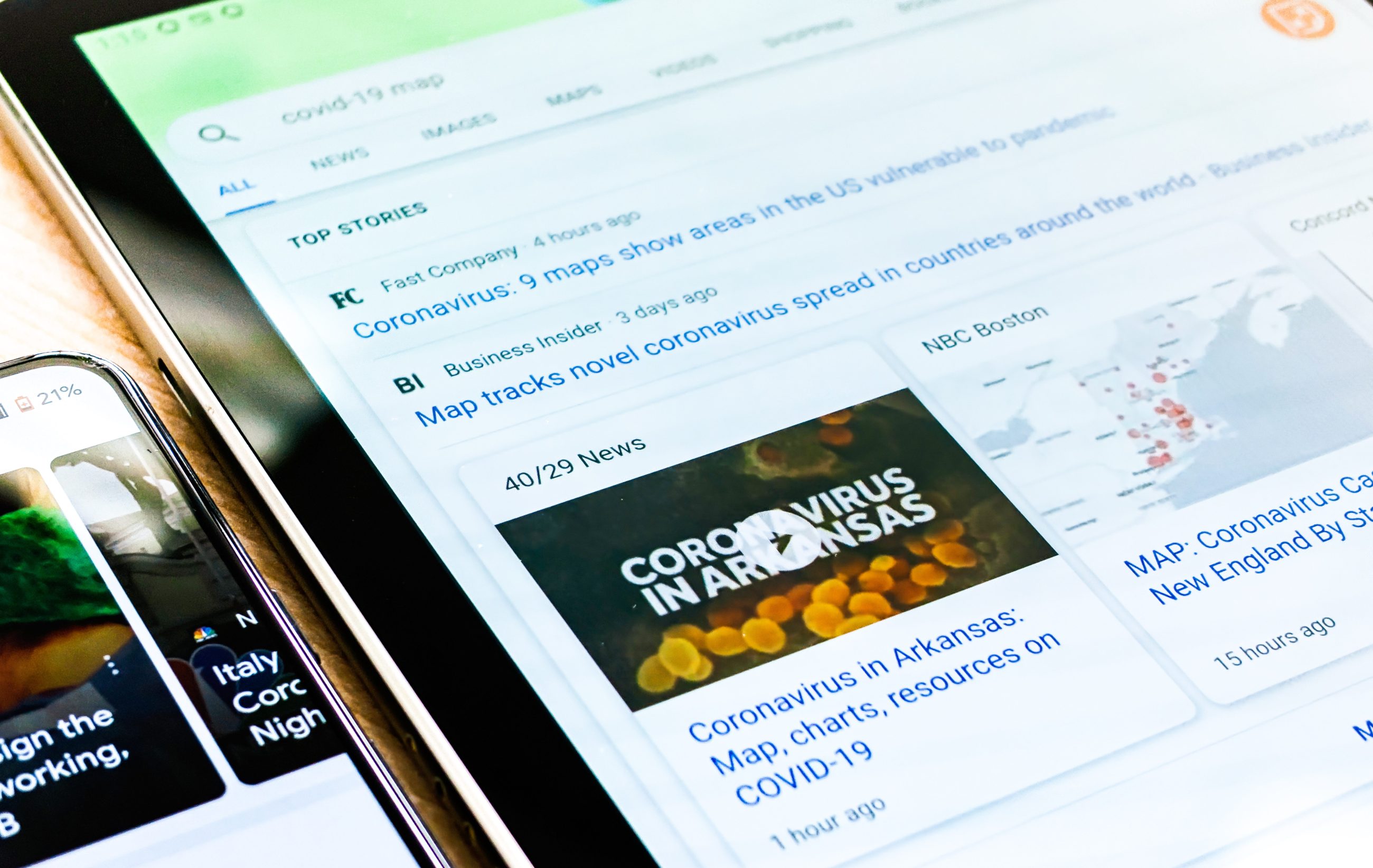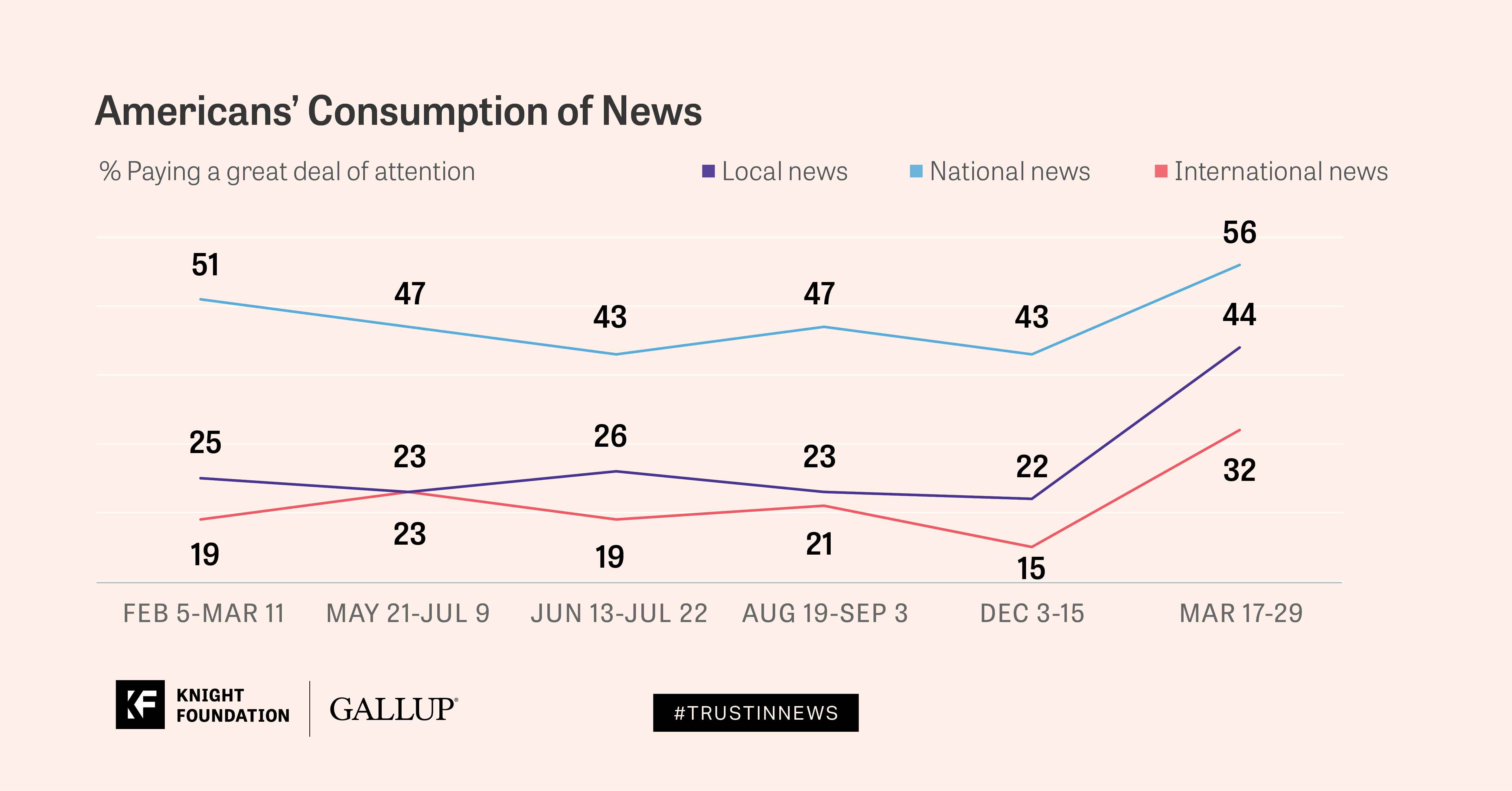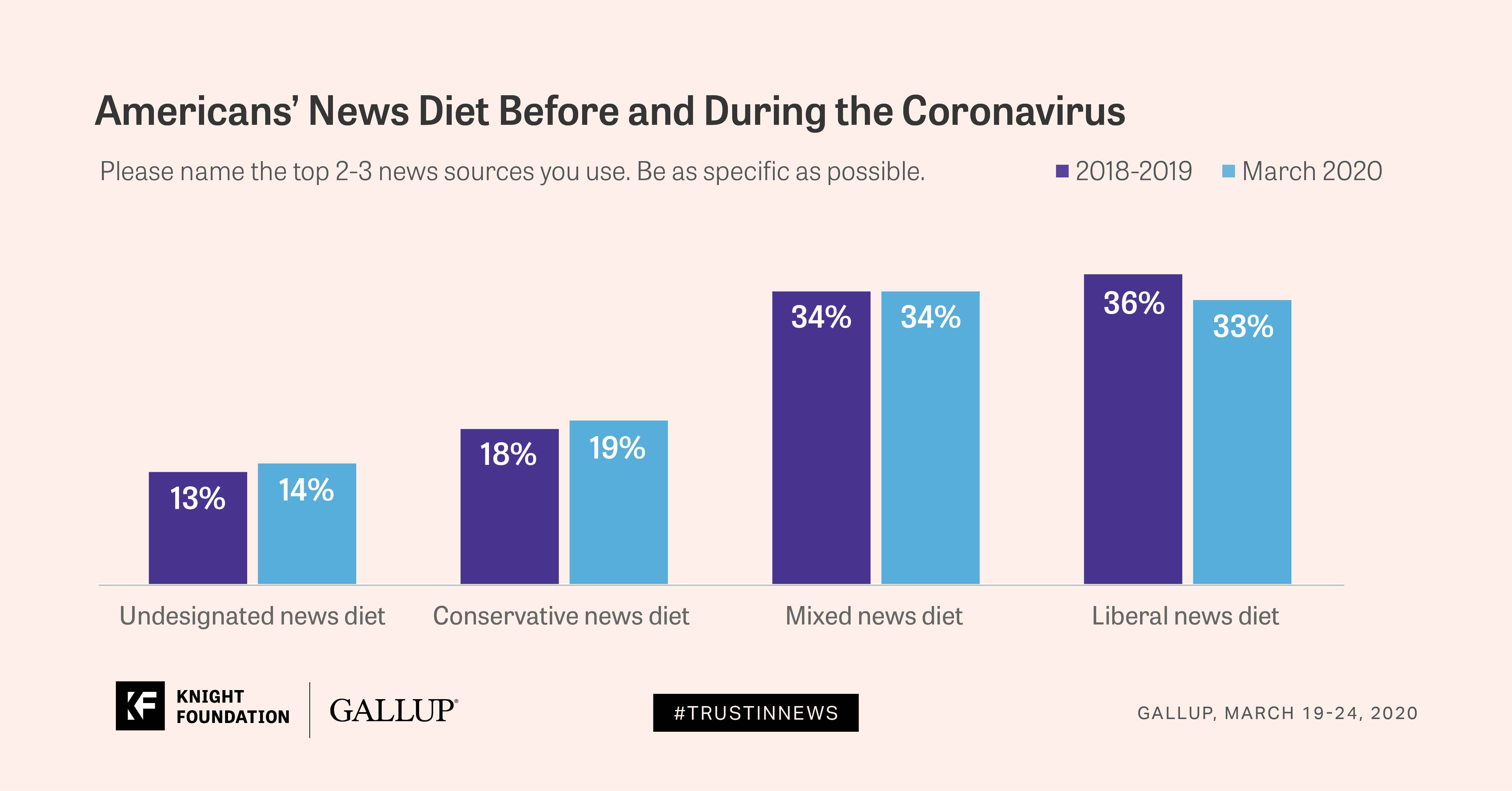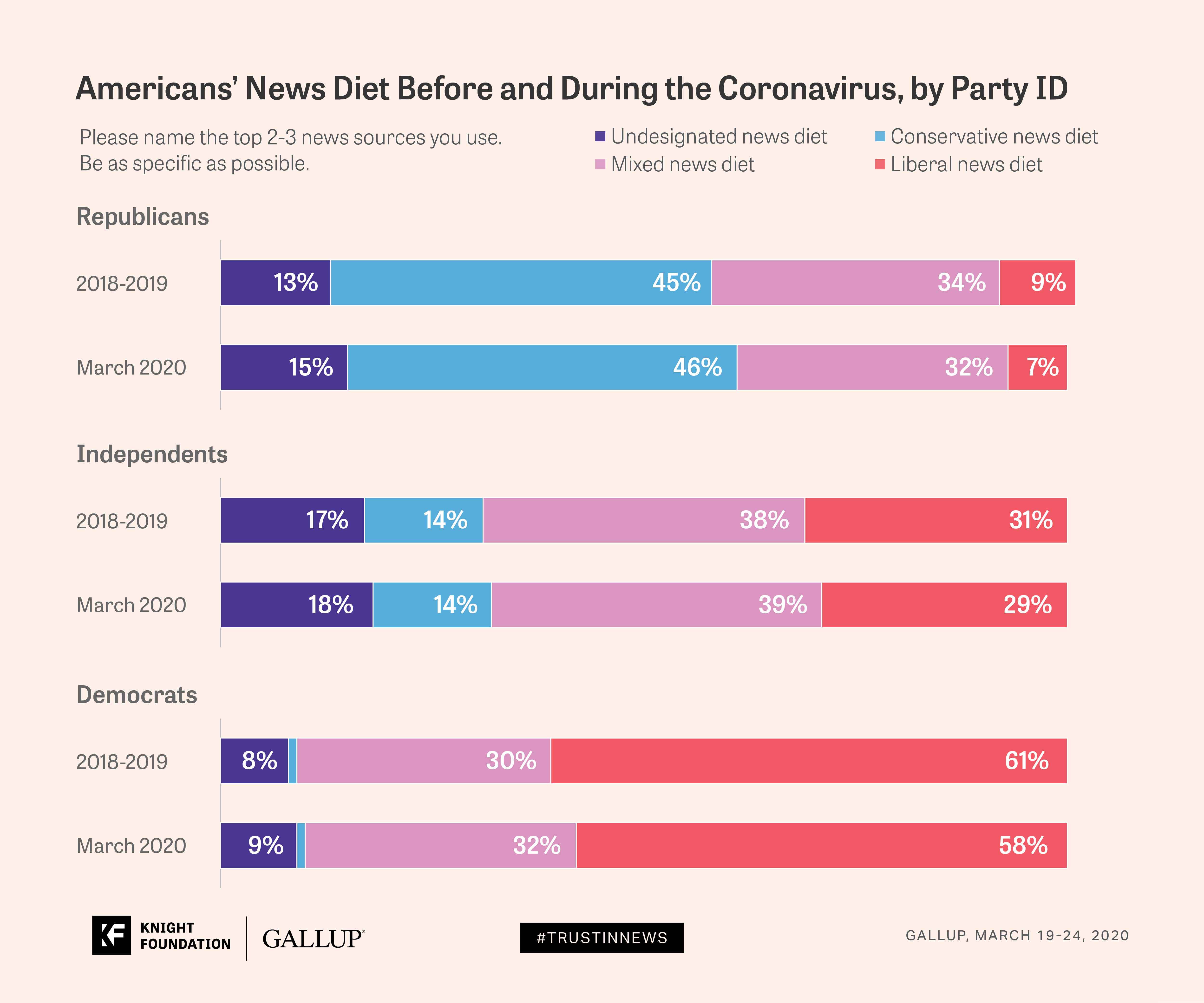
Amid Pandemic, News Attention Spikes; Media Favorability Flat
This piece was originally posted on Gallup.com on April 9, 2020.
As news about the novel coronavirus has gripped the country in recent weeks, a series of Knight Foundation/Gallup surveys finds that Americans are paying “a great deal” of attention to the news at levels not seen over the past three years. Attention to local and international news has doubled since December 2019, and attention to national news has increased 13 percentage points.

These findings are from an online, probability-based Gallup Panel survey conducted March 17-29 with 1,449 U.S. adults.
Despite the spike in news attention, general attitudes toward the media remain unchanged. Like the 2018 and 2019 results, 34% of Americans currently hold a very favorable or somewhat favorable view of the media, an opinion strongly shaped by partisan affiliation.

Meanwhile, the 48% of Americans with an unfavorable opinion of the media is in line with prior years’ readings.
Where Do Americans Go for News During the Coronavirus Pandemic?
Almost all Americans have heard either a great deal (82%) or quite a lot (15%) about the coronavirus. Seventy-eight percent say news organizations are a major source for information about the coronavirus, while 62% say this about a website for a health agency or institution; 31% say doctors; and 12%, family and friends.
Given the central role news organizations play in distributing information about the coronavirus, Americans’ news diets — that is, the top news sources they consume — may contribute to emerging attitudes and beliefs about the unfolding crisis.
To understand this relationship, we asked Americans to name their top news sources. We then grouped the responses into four different categories, based on the ideological mix of those sources, according to separate coding schemes developed by third-party researchers.
- “Conservative news diet” describes those who cite only conservative news sources (e.g., Fox News, Breitbart, One America News, the National Review) as top sources.
- “Liberal news diet” is assigned to those naming only liberal news sources (e.g., MSNBC, The New York Times, CNN, Vox) as top sources.
- “Mixed news diet” includes those who name multiple sources that cut across partisan lines (e.g., National Review and The New York Times) or include neutral sources (e.g., the Associated Press, USA Today, The Economist).
- “Undesignated” refers to those who provide generic categories (e.g., internet, TV, newspaper) or who did not answer the open-ended question.
Americans’ news diets have largely persisted during the coronavirus situation compared with before it. Overall, 33% of U.S. adults now have a liberal news diet, 34% a mixed diet and 19% a conservative diet.

Partisan affiliation is closely tied to news diet: 58% of Democrats in the March 2020 polling have a liberal news diet, and 46% of Republicans have a conservative news diet. Still, roughly one-third of Democrats (32%) and Republicans (32%) have a mixed news diet, as do a plurality (39%) of independents.

News Diet and Attitudes Toward COVID-19-Related Issues
In the latest Knight/Gallup survey, Americans were asked to rate President Donald Trump’s handling of the U.S. response to COVID-19; to assess the level of attention given to the coronavirus by the media; and to answer whether the coronavirus is more deadly than the seasonal flu.
Consistent with other research, Americans’ news media diets are strongly related to their views of the coronavirus. However, this study indicates that the effects of news diet on the knowledge versus attitudinal questions differ once political identity is taken into account.
Over half of Americans with a conservative news media diet (57%) believe COVID-19 is no more deadly than the seasonal flu, compared with 36% who have a mixed news diet and 28% with a liberal news diet. As messages from conservative and Republican leaders have become more aligned with scientific consensus about the seriousness of the threat posed by the coronavirus, it is possible the gap between these groups has narrowed since these data were collected in late March.
The survey found even larger gaps between those with liberal versus conservative news diets on whether the media is giving too much attention to the coronavirus (28% and 71%, respectively) and whether Trump is doing an excellent or good job of handling the U.S. response to coronavirus (11% and 94%, respectively).
Yet, attitudes of partisans with differing news diets are very similar, especially concerning knowledge about the health dangers posed by the coronavirus, indicating news diet may not do much to change one’s existing biases in favor of one political party or the other.

A regression analysis that accounts for effects of partisanship, news diet, ideology and other factors (like education) finds that news diet is not a meaningful predictor of whether a respondent thinks the coronavirus is deadlier than the seasonal flu.
Importantly, education is strongly associated with this misperception about the coronavirus. Americans with a four-year college degree are about half as likely as those without one to say the coronavirus is no more deadly than the seasonal flu. This effect holds across partisan lines and suggests that education offers individuals a set of tools to navigate a challenging information environment and distinguish between truth and falsehood.
In contrast to the knowledge question about the lethality of coronavirus, news diet does predict attitudes toward the performance of familiar friends and foes, like Trump and the media. An individual with a conservative news diet is 10 percentage points more likely to say the media is giving the coronavirus too much attention than a similar individual with a liberal news diet. An individual with a conservative news diet is almost twice as likely as a similar individual with a liberal news diet (58% and 33%, respectively) to say Trump is doing an excellent or good job.
Implications
While the coronavirus has prompted more Americans to pay attention to news, it has not done anything to improve the image of the news media in Americans’ eyes.
This survey reveals a close relationship between partisanship, news media diet and coronavirus-related attitudes. While Americans’ news diet does appear to amplify their preexisting partisan bias about how the president and news media have handled the crisis once partisan identity is taken into account, news diet does not appear to affect their knowledge of the virus.
The partisan difference concerning the lethality of COVID-19 does not appear to be an artifact of echo chambers or filter bubbles. The root cause for this misperception seems more nuanced. Partisans exposed to countervailing messages through a mixed media diet were as likely to know the correct answer about the deadliness of the coronavirus as those exposed to a one-sided media diet. During this time of potential national crisis, Americans tended to believe the messages and messengers matching their partisan identities when a discrepancy over basic health facts arose.
Motivated reasoning — the tendency to find messages we want to believe as more convincing — appears to be the primary driver of this partisan gap. Democrats were more inclined to believe messages from messengers who characterized COVID-19 as a grave threat. In contrast, Republicans tended to believe the messages from messengers who said COVID-19 was not as great a threat as the media and experts were predicting.
Read more from the Gallup/Knight series on trust, media and democracy.
Photo (top) by Obi Onyeador on Unsplash
Putting a Price Tag on Local News
Americans’ Perceptions of the Value and Financial Future of Local News Learn more about the report, “Putting a Price Tag on Local News” by reading this blog post by John Sands, Knight Foundation director for learning and impact and watching the panel discussion, embedded below. For more, listen to “Out of the Echo Chamber,” a […]
When it comes to local news mergers, bias top concern
This piece was originally published on Gallup.com on August 15, 2019. In recent years, efforts to find a sustainable business model for local news coverage in the U.S. have resulted in the acquisition of local news organizations in different markets by large, national companies. Last week’s announcement of a merger between Gannett and Gatehouse media, […]
Trust, media and democracy
How are Americans navigating the changing media landscape and what does that mean for our democracy?
Recent Content
-
Journalismarticle ·
-
Journalismarticle ·
-
Journalismarticle ·





